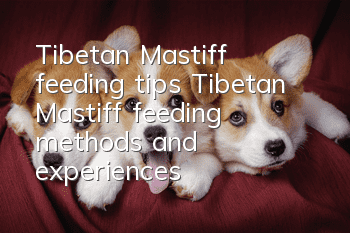Tibetan Mastiff feeding tips, Tibetan Mastiff feeding methods and experiences

The Tibetan Mastiff has footprints in many countries and regions in the world. The original Tibetan Mastiff lives in the alpine zone of the Qinghai-Tibet Plateau at an altitude of more than 3,000 meters and the Central Asian plains. It can be found in Tibet, Qinghai, Sichuan, Gansu, Nepal and even Xinjiang, Mongolia and Ningxia. Found traces of Tibetan Mastiff. The Tibetan Mastiff is universally recognized as the oldest and only remaining rare dog breed in the world. In the ancient East, the magical legends about the Tibetan Mastiff have been mythologized as the embodiment of heroic guardian deeds. His loyal and protective nature makes him not only the best protection dog for nomads, but also considered the best protection dog for kings and tribal leaders.
Tibetan Mastiff Feeding Methods and Experience 1. It is not good to feed Tibetan Mastiffs only with meat
Some people think that feeding Tibetan Mastiffs with the best meat can make them grow strong. In fact, feeding Tibetan Mastiffs in this way is not only expensive, but also causes diarrhea in most Tibetan Mastiffs, causing indigestion and difficulty in absorption. In order to obtain energy, Tibetan Mastiff puppies need to break down the protein of meat; in fact, these can be obtained from carbohydrates. In addition, vitamins A, D, and E are also lacking in meat.
Under normal circumstances, any Tibetan Mastiff puppy that is fed too much meat or is fed only with meat (especially from 3 months to 12 months old) must have problems with the formation of bones, because calcium and meat Phosphorus imbalance. In other words, there is less calcium and more phosphorus. In addition, feeding only meat can also cause malnutrition in puppies and cause rickets.
Tibetan Mastiff Feeding Methods and Experience 2. Tibetan Mastiff puppies should not be fed milk
Most people believe that drinking milk for Tibetan Mastiff puppies is beneficial to the healthy growth of Tibetan Mastiff puppies. They often feed some milk to newly brought home Tibetan Mastiff puppies. However, they do not know that Tibetan Mastiff puppies are not suitable for drinking milk. Most of them will become pregnant after drinking milk. Diarrhea, and even gastrointestinal catarrh. Because the ingredients of dog milk and cow's milk are completely different. Dog milk contains high protein, high fat and low lactose, while cow's milk contains low protein, low fat and high lactose. The composition of the two is exactly the opposite. If milk is used as feed for puppies and Tibetan Mastiffs drink too much, their stomachs will not have enough lactase to digest the excess lactose, which will cause diarrhea. Dogs that drink some milk after they reach 6 months of age will generally stop having diarrhea.
Tibetan Mastiff Feeding Methods and Experience 3. Do not feed Tibetan Mastiff puppies chicken bones
Many Tibetan Mastiff puppies like to eat chicken bones, and their owners also think that it is natural for dogs to chew bones, but this view is exactly wrong. Regardless of the size of chicken bones, owners should not feed them easily because chicken bones are very hard and cannot be digested by Tibetan Mastiffs. If chicken bones are broken into pieces, the fragments will be in the shape of edges, which can easily puncture the gastrointestinal mucosa of Tibetan Mastiff puppies and cause traumatic gastroenteritis. Initially, there may be white stools, followed by mucus in the stools, sometimes intermittent with vomiting, and finally bloody stools. At this time, you should send it to the pet hospital for treatment as soon as possible.
(1) Do not give Tibetan Mastiff puppies the opportunity to swallow chicken bones, ribs or fish bones, because they will remain in thethroat, then fragments and, if not retained in the throat, can slip into the body and pierce the stomach wall and intestines.
(2) Don’t let Tibetan Mastiff puppies eat people’s leftovers, because dogs have different nutritional needs from humans. If you use human recipes to prepare dog food, it will not only be time-consuming and labor-intensive, but it will also be difficult for your dog to get a complete and balanced intake. nutrition. There are many brands of dog food on the market now. This kind of feed is formulated through scientific methods. It is delicious, nutritious, easy to digest and absorb, and very convenient to use. According to statistics, dogs who eat dog food for a long time live more than one-third longer than dogs who do not eat dog food. Moreover, the odor of body odor, breath and excrement will also be reduced a lot, which is good news for dogs living in apartments.
(3) Do not give snacks to the Tibetan Mastiff puppy between each meal. If it obeys other training, you can give the Tibetan Mastiff some snacks to show encouragement.
(4). Remember not to let Tibetan Mastiff puppies eat at the table, because this will develop a bad habit of begging for food. Specific foods can only be fed at designated times and places. The food is only placed in the puppy's bowl and cannot be fed with other food utensils. In addition to this, don’t forget to provide your dog with plenty of clean water.
Tibetan Mastiff Feeding Methods and Experience 4. Tibetan Mastiffs should be fed regularly and quantitatively:
——Timing means that the feeding time should be fixed every day and cannot be delayed. Regular feeding can regularly strengthen the gastric juice secretion and gastrointestinal motility of dogs every feeding time, intensify hunger, greatly increase appetite, and is of great benefit to food intake, digestion and absorption. If not fed regularly, this pattern will be violated, which will not only affect feed intake and digestion, but also make the animal susceptible to digestive tract diseases. Quantification means that the amount of feed fed every day should be relatively stable, not more and sometimes less, to prevent the Tibetan Mastiff from not being full or overeating. However, it should be noted that the food intake of different individuals may vary greatly, and it must be determined by the breeder's own observation. Generally speaking, Tibetan Mastiffs of different weights need different feeding amounts every day. The characteristic of Tibetan Mastiff eating is to simply chew food and swallow it whole, especially when several Tibetan Mastiffs share a food bowl. Therefore, each Tibetan Mastiff should have a fixed food bowl and do not exchange them to prevent the spread of diseases. The food basin should be larger, and do not add too much food each time. It is appropriate to cover the bottom of the basin, let the Tibetan Mastiff lick food, and then add food after eating, so that it can develop the habit of not leaving any food. Tibetan Mastiffs have the habit of sleeping and eating in fixed places, so the feeding place should be relatively fixed. Some Tibetan Mastiffs often refuse to eat or have a significant decrease in appetite after changing feeding places.
- Precautions for feeding Doberman puppies
- Misunderstandings about dog vaccinations
- What to do about alopecia in Bichon Frize? How to treat alopecia in Bichon Frize?
- What should I do if my Australian Cattle Dog vomits after eating too much?
- Dogs with these symptoms may be canine heartworm disease, so owners should pay attention!
- Out of ten dogs, nine have urinary tract infections!
- Dogs need to take these steps to prevent kennel cough in winter!
- What's wrong with a puppy vomiting food? It's not energetic.
- Do Neapolitan dogs bite_Neapolitan dog prices|pictures
- What are the symptoms of canine distemper in American Cocker Spaniels?



